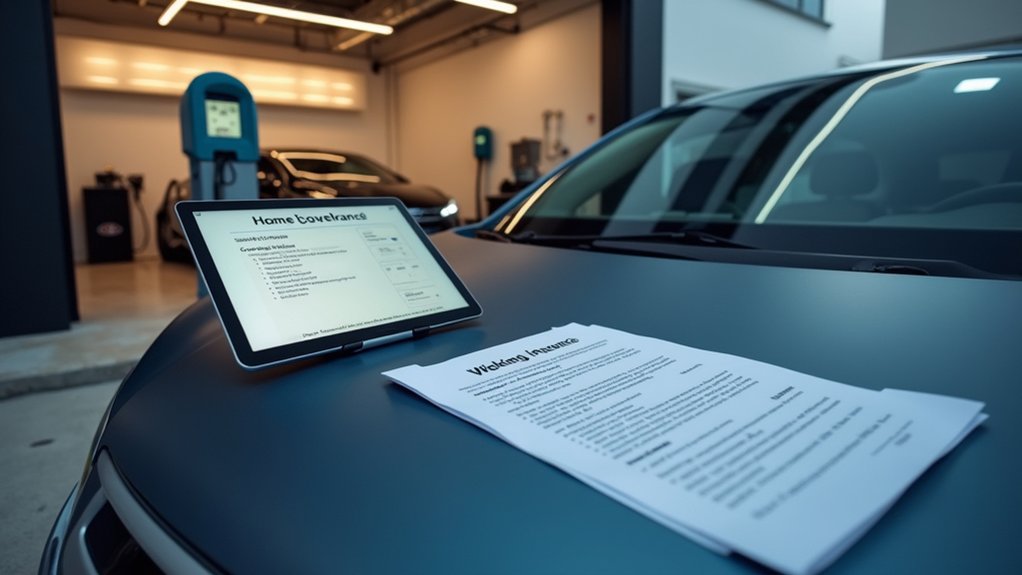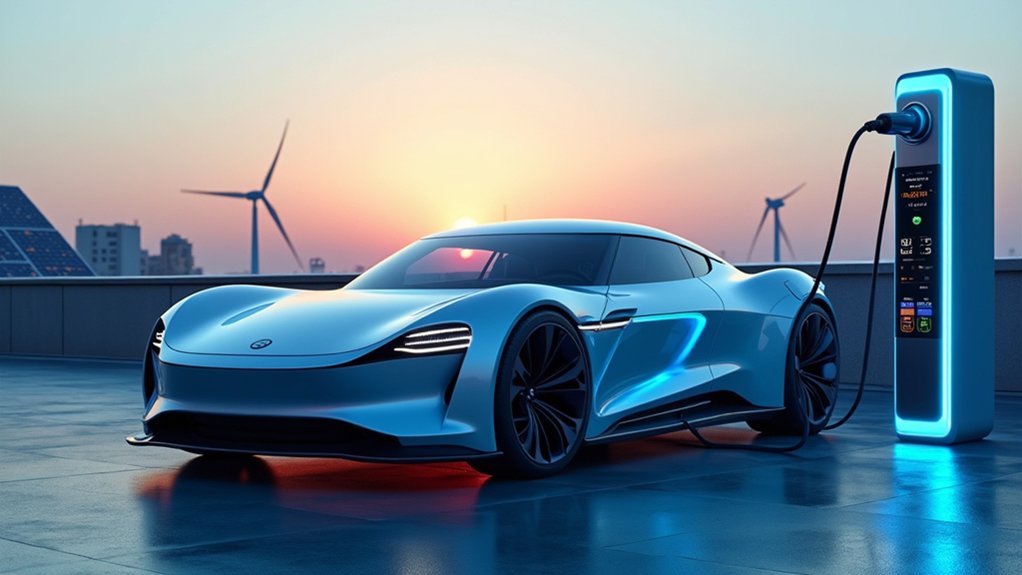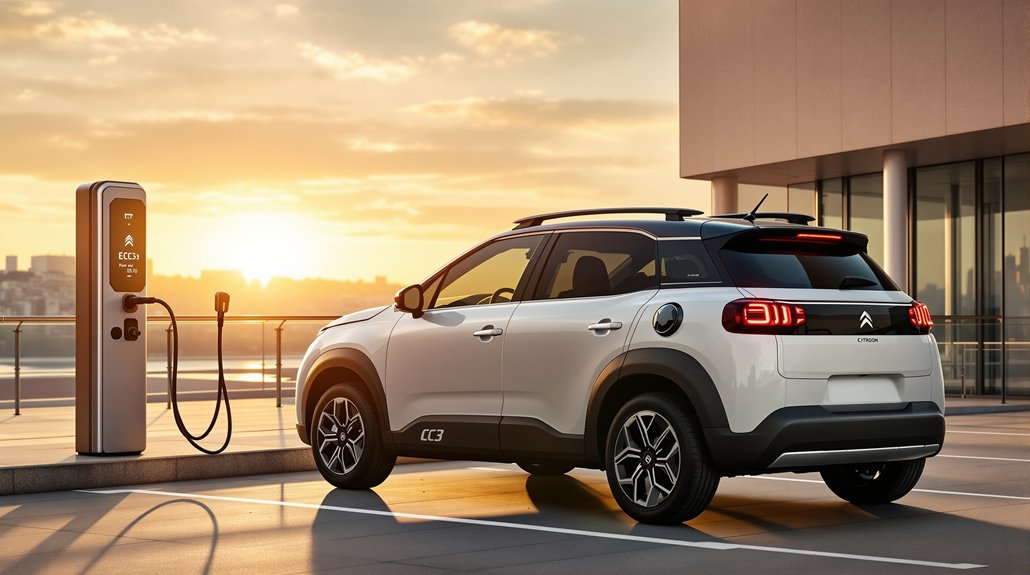Electric vehicle insurance presents distinct challenges due to advanced technology and specialized components. EV premiums typically exceed traditional vehicle rates, often surpassing $3,000 annually for full coverage. Key factors include expensive battery systems, which can cost over $20,000 to replace, and the need for specialized repair facilities. While eco-friendly discounts may offset costs, thorough coverage requires careful consideration of battery protection, charging infrastructure, and model-specific features. Understanding these unique aspects forms the foundation for ideal EV coverage selection.

How does insurance coverage differ when shifting from a conventional vehicle to an electric one? While the fundamental structure remains similar, with standard offerings like liability, collision, and extensive coverage, EV insurance presents unique considerations that impact both coverage options and expenses.
Insurance premiums for electric vehicles typically exceed those of traditional cars, with annual full coverage rates often surpassing $3,000 for many models. The higher costs stem primarily from the sophisticated technology and expensive components inherent in electric vehicles, particularly their battery systems. USAA offers comprehensive battery protection under their EV policies. Some insurers provide eco-friendly discounts for electric vehicle owners to help offset premium costs.
EVs command higher insurance premiums due to their complex technology and costly components, particularly the sophisticated battery systems powering these vehicles.
Major insurers like Geico, Progressive, and State Farm have adapted their coverage options to address these specific needs, with some offering specialized policies that include dedicated battery coverage. The claims process for EVs often requires specialized knowledge and repair facilities, which contributes to the overall cost structure. Many insurance providers now offer infrastructure grants to support the installation of home charging stations.
Vehicle model selection greatly influences premium rates, with luxury EVs commanding considerably higher insurance costs. Advanced safety features, such as automatic emergency braking and lane departure warning systems, can help offset these expenses through reduced risk assessments.
Geographic location plays an important role too, with urban areas typically generating higher premiums due to increased accident risks and theft rates. The insurance industry has embraced technological innovations in EV coverage, with some providers implementing telematics programs to evaluate driving behavior and adjust premiums accordingly.
Tesla Insurance, for instance, utilizes real-time driving data to offer personalized rates. Smart comparison shopping among multiple providers remains essential, as coverage options and pricing can vary dramatically.
State regulations continue to evolve regarding EV insurance requirements, making it vital for owners to stay informed about minimum coverage mandates. Organizations focusing on electric vehicles often provide member discounts, presenting opportunities for cost savings.
When evaluating policies, particular attention should be paid to battery coverage terms, as battery replacement costs can exceed $20,000 for some models. The combination of these factors makes thorough research and careful policy selection essential for ideal EV coverage.
Frequently Asked Questions
Does My EV Insurance Cover Damage to the Charging Station?
Coverage for charging station damage depends on several key factors.
Homeowners insurance may cover residential charging units as part of dwelling coverage, while commercial property insurance typically protects business-installed stations.
For personal EV chargers, standard auto insurance generally doesn’t cover charging equipment damage.
Property damage coverage and equipment breakdown insurance offer the most thorough protection for charging infrastructure, subject to policy terms and specified perils.
What if My Battery Fails After the Manufacturer’s Warranty Expires?
Battery failure after warranty expiration presents significant financial exposure, with replacement costs ranging from $5,000 to $22,000 for standard EVs.
Owners have several mitigation options: purchasing extended warranties, exploring third-party insurance coverage, or considering refurbished battery packs.
While post-warranty failures are rare (1.5% occurrence rate), prudent owners should evaluate these protective measures.
Battery recycling programs and advancing technology may reduce future replacement costs.
Are There Discounts for Installing Home Charging Equipment?
Several financial incentives exist for home charging equipment installation.
Insurance providers frequently offer policy discounts for homes with certified EV charging setups, while government programs provide tax credits and rebates.
Local utilities often supplement these savings with additional incentives for off-peak charging.
When combined with reduced charging costs and potential property value increases, home charging infrastructure typically delivers strong returns on investment through multiple discount channels.
How Does Extreme Weather Affect My EV Insurance Coverage?
Extreme weather considerably impacts EV insurance premiums, particularly thorough coverage rates.
Natural disasters and severe conditions can cause extensive damage to EVs’ sensitive electrical systems and batteries, resulting in costly claims. Flooding poses special risks, potentially causing catastrophic battery failure and electrical system damage.
Insurance companies typically adjust rates based on regional weather patterns and may impose higher deductibles or coverage limitations in high-risk areas.
Regular maintenance and garage parking can help mitigate weather-related premium increases.
Will Modifications to My Ev’s Software Impact My Insurance Coverage?
Software modifications to EVs can considerably impact insurance coverage, potentially voiding policies or increasing premiums.
Insurers typically view unauthorized software changes as high-risk modifications that may compromise vehicle safety systems. Most policies require explicit disclosure of any software alterations, while aftermarket modifications often face heightened scrutiny.
Third-party software installations particularly concern insurers due to potential liability issues and system compatibility risks.









